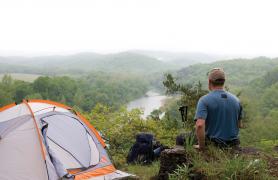Missed opportunities weighed heavily on the mind of 10-year-old Luke Dierker that morning. It was the final day of youth firearms deer season, and he was definitely feeling the pressure. When a nice doe stepped into range, Luke knew the moment of truth had arrived. He took a deep breath and let his Remington 700 ring out across the Lamine River valley. The doe went down, and Luke’s persistence was rewarded!
To add to the excitement, Luke’s dad, grandpa, little brother, and cousin all shared in the experience at that private farm in Cooper County. The Dierkers are a hunting family.
Luke’s dad, Ryan, age 33, started hunting when he was just 4 years old, learning much of what he now knows from his father, Jim. Today, Ryan is working to pass on the tradition to his boys and give them the skills they need to be successful. “I’m always looking for good places to take the family hunting,” said Ryan Dierker. That’s why he was intrigued when a friend told him MDC was working on a new walk-in hunting and fishing program for the state. “I got on the internet and quickly discovered the name of the program,” Ryan Dierker explained. “It was the Missouri Outdoor Recreational Access Program.”
Program Rewards Landowners for Providing Access
Put simply, the Missouri Outdoor Recreational Access Program (MRAP) is designed to give people more opportunities to get out and enjoy nature. To do this, MDC offers incentive payments to private landowners who volunteer to open their property to the public for outdoor activities like hunting, angling, and wildlife viewing. While this concept may be new to Missouri, it’s relatively old hat in other states like Kansas and Nebraska, where similar programs have operated for years.
In 2015, Missouri was one of 15 states to be awarded federal grant monies from the U.S. Department of Agriculture (USDA) to help fund recreational access programs. Through the Voluntary Public Access and Habitat Incentives Program (VPA-HIP), MDC is receiving up to $1.1 million from the USDA Natural Resources Conservation Service for this effort. These funds, along with MDC and partner contributions, are being used to enroll 10,000 to 15,000 acres over a three-year period.
Good for Landowners, Recreationists, and Wildlife
The main purpose of MRAP is to enhance public access opportunities for people in Missouri, especially in areas close to major urban centers and where public land availability is relatively limited. The idea is to provide more places for people to enjoy the outdoors closer to home.
MRAP can also provide a means for the public to use and enjoy private lands that have already been improved for wildlife through other programs, such as the USDA Conservation Reserve Program (CRP) or the Environmental Quality Incentives Program (EQIP). For example, Ryan Dierker and his family decided to deer hunt last season on the Knedgen Bottoms MRAP tracts. Prior to MRAP enrollment, these properties had already been enhanced for wildlife through the federal Wetland Reserve Program (WRP).
While the obvious benefit to landowners is the incentive payment they receive, MRAP participants can realize other advantages as well. One of the owners of the Knedgen Bottoms MRAP tracts, Don Knedgen, explained. “We previously leased the hunting rights of our farms to an out-of-town company. A big reason that MRAP interested me and my father was that it offered us the chance to share the land with local hunters and give them a place to enjoy.” Many participating landowners also find value in the liability protection offered to them through Missouri’s Recreational Use Immunity Law. This statute offers immunity to landowners who permit outdoor recreation without charge or through a state-administered recreational access program such as MRAP.
Another primary goal of MRAP is to benefit wildlife populations on private land. Through various program incentives, participating landowners are encouraged to complete new wildlife habitat practices, which can benefit game and nongame species alike for years to come. This means MRAP potentially spells win-win-win for the landowner, the public, and Missouri’s wildlife.
Different Properties Offer Different Opportunities
MRAP was designed to offer something for everyone. “We wanted Missouri’s public access program to be attractive to a variety of landowners and outdoor enthusiasts,” explained Lisa Potter, MDC private land programs supervisor. Therefore, not all MRAP properties are the same. Participating landowners choose the type of activities that may occur on their property. “They do this by selecting one of six access options,” Potter explained. These options include all-access hunting and fishing, small game and turkey hunting, youth hunting and fishing, archery hunting, fishing only, and wildlife viewing only. Currently, there are properties enrolled under four of these six access options. Whether you are looking for hunting, hiking, fishing, or bird-watching opportunities, it may be worth checking out MRAP.
Quality Habitat Makes for Quality Experiences
“In order for this program to be successful, our enrolled properties must be capable of providing quality outdoor experiences to their visitors,” explained Private Land Services Division Chief Bill White. “Consequently, we established minimum size and habitat requirements for the program.” When a landowner offers land to MRAP, a detailed property evaluation is conducted to determine if the qualifications are met and to calculate the potential payment rate. Except for fishing-only properties, offered lands must be at least 40 acres in size and at least 20 percent of the property must consist of quality wildlife habitat.
To be designated as quality habitat, wildlife-friendly management practices must have been completed, or the area must score high on a habitat evaluation. Thus, MRAP guests are likely to observe a number of management practices, such as timber stand improvement, native grass establishment, or edge feathering during their visit.
Anticipating that the number of acres offered by landowners would quickly exceed funding levels, MDC developed an application ranking system to select the eligible properties that promise the best outdoor experiences for visitors.
Criteria such as habitat quality and quantity, willingness to implement new habitat management practices, property size, and location all go into the ranking calculations. Eighty-two percent of MRAP guests rated the habitat as good or excellent during the 2016–17 hunting season, suggesting that desirable properties are being enrolled. In fact, over 50 percent of the acres enrolled in MRAP are designated as quality habitat.
Recreating on MRAP Lands
Finding suitable MRAP lands to visit is very similar to finding MDC conservation areas online. To search for MRAP lands that host your intended activity, visit mdc.mo.gov/mrap. “Our first step was to find enrolled properties on the internet,” explained Ryan Dierker. “Then we picked out two properties in our target area that allowed deer hunting. We printed maps of those properties and went to check them out. The property boundaries were pretty well marked with MRAP signs, which was very helpful. Ultimately, we decided to hunt on the Knedgen Bottoms tracts.”
Visitors should keep in mind that MRAP properties are not the same as public lands. While MRAP tracts must contain minimum amounts of wildlife habitat, many of the properties also include areas with limited wildlife value, such as pastures and hayfields. In addition, visitors shouldn’t expect to see many of the amenities like mowed walking paths, wildlife food plots, and gravel parking lots that are common on MDC areas. “Unless designated otherwise, parking is along public roadsides,” explained Potter. “Approved parking locations are shown on the property maps.”
Looking to the Future
Like any fledgling program, MRAP faces a number of unknowns. One big question is whether visitors will treat the enrolled lands with respect and follow the rules. That was one of Don Knedgen’s concerns when he decided to enroll his farm. “So far, people have been keeping the area cleaned up, and we haven’t noticed any problems or damage,” Knedgen said. Ryan Dierker agreed that public behavior will probably dictate the future success of the program.
Bill White wonders how the program might impact neighboring landowners and how wildlife numbers on enrolled properties will respond. Surveys of public visitors, participating landowners, and neighbors are conducted to evaluate these types of questions, make needed program changes, and assess future program improvements.
As far as Ryan Dierker is concerned, MRAP could have a big future in Missouri, and he is excited about the possibilities it holds. “MRAP opens up new opportunities for guys like me and my family who are willing to try new things and put in the work. In the future, I hope to see even more land in the program,” Dierker said.
Find Private Land Recreation Opportunities Near You
- Approximately 8,400 acres currently enrolled in MRAP.
- For property listings, maps, and rules, visit mdc.mo.gov/mrap.
- Respect the land as if it were your own and act responsibly.
- Remember that special regulations apply on MRAP lands.
- MRAP areas are walk-in only.
- Park and self-register at designated access points.
- Public access hours are from one hour before sunrise until one hour after sunset.
- No equipment or gear (including deer stands) may be left on the property overnight.
- Obey all Missouri hunting and fishing regulations.
- Familiarize yourself with the boundaries and do not trespass onto neighboring property.
Is Your Land Right for MRAP?
- MDC is currently accepting applications for 2018 enrollment.
- The deadline to apply is Nov. 1.
- Minimum 40 acres of land or 1 acre of fishing impoundment.
- Land must have existing quality habitat such as native grasses, managed forests, or restored wetlands.
- You can determine the permitted activities.
- You can continue most farming and property management activities.
- State law offers liability immunity.
- For more information, contact your local MDC representative or visit mdc.mo.gov/mrap.
















Also In This Issue


And More...
This Issue's Staff
Associate Editor - Bonnie Chasteen
Staff Writer - Larry Archer
Staff Writer - Heather Feeler
Staff Writer - Kristie Hilgedick
Staff Writer - Joe Jerek
Creative Director - Stephanie Thurber
Art Director - Cliff White
Designer - Les Fortenberry
Designer - Marci Porter
Photographer - Noppadol Paothong
Photographer - David Stonner
Circulation - Laura Scheuler






















